
Jing Ying Chiang
People who can readily share others’ feelings are labelled as ‘empathic’, and are perceived to be better at recognising others’ facial emotions. However, it is uncertain whether positive emotions could decrease their emotion recognition due to positive bias. Therefore, this study examined if empathic concern and positive emotional states could influence emotion recognition accuracy among Malaysian Chinese young adults. Using a between-subjects experimental design, 80 participants aged 18-30 were randomly assigned to two groups, in which they were asked to recall either an empathic or positive event. Then, they were asked to complete a facial emotion recognition task (happy, sad, angry, fear, disgust, surprise, neutral) and the Interpersonal Reactivity Index (IRI) to measure their empathic level. Results showed no significant difference between both recall conditions in emotion recognition accuracy. When the data was split by recall conditions, there was a positive correlation between empathic level and emotion recognition accuracy in the induced empathic condition; but a negative correlation in the induced positive condition. To conclude, these findings suggest that the relationships between empathic concern, positive emotions and emotion recognition accuracy may not be as simplistic as expected. Therefore, further research is needed to identify potential moderators of these relationships.

Jing Ying Chiang
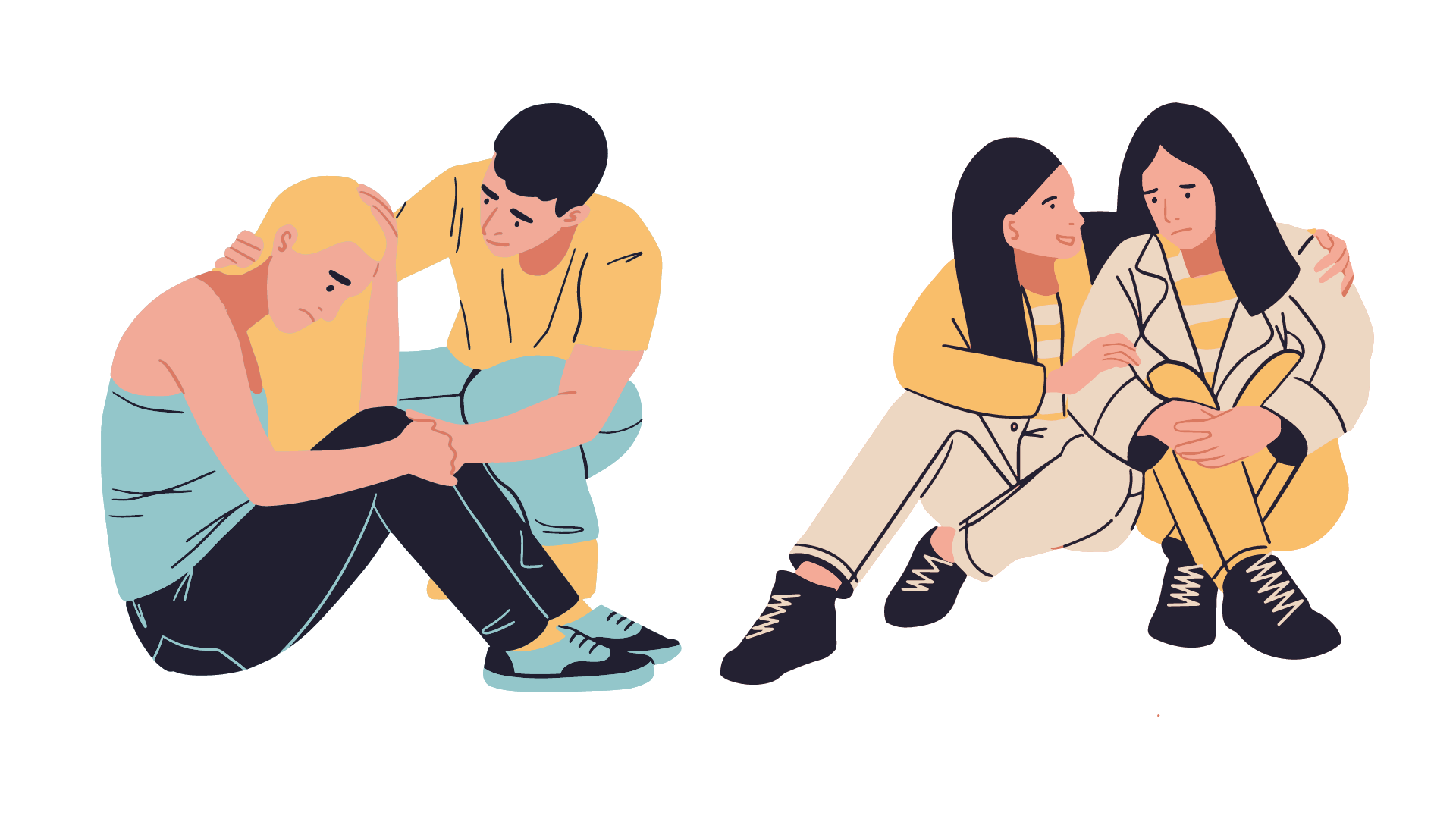
What is Empathy?
The ability to recognise, share and concern about others' inner feelings (Zaki, 2019).

Early Days of Empathy
Babies tend to react to perceived distress in surrounding others with contagious crying (Sagi & Hoffman, 1976).
Therefore, empathy could be traced back to as early as infancy.
However ...
Before one could feel and experience the others' emotions, first of all, a person needs to be able to recognise emotions based on facial expression.

This raises the question:
Empathy Facial Emotion Recognition?
Before diving any further, there are actually two models which explain how empathy comes into being (Israelashvili et al., 2020).
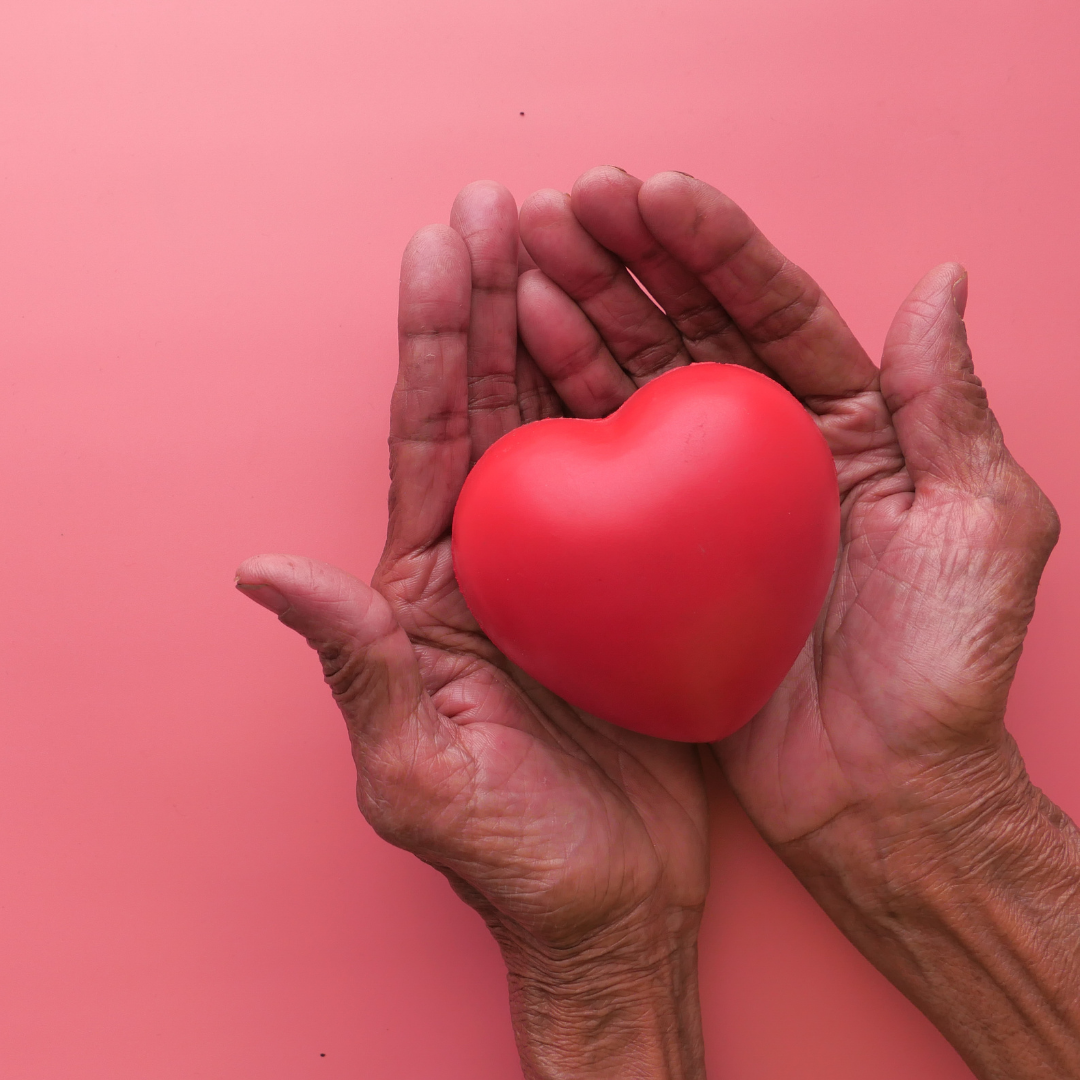
1. Affect-to-Cognition Model (ACM): The observation of facial expressions leads to emotional sharing, which then allows one to understand with what the others are going through (Riess, 2017).
2. Cognition-to-Affect Model (CAM): The understandings of other people's thought would lead to emotional sharing.
Research has shown a stronger support for ACM because affective empathy can be developed rapidly by simply exposing a person to other people's plight (Israelashvili & Karniol, 2018). Therefore, this present study focused mainly on affective empathy.
What does research says about affective empathy & facial emotion recognition?
- The inconsistency in findings could be attributed to the difference in operational definition of affective empathy (Israelashvili et al., 2020).
- Affective empathy is commonly measured by using the two components outlined in the Interpersonal Reactivity Index (IRI), namely empathic concern (EC) and personal distress (PD), whereby these two elements often exert opposing impacts on empathy-related behaviours.
- For evidence, individuals with high EC tend to pay more attention to emotional cues so that they could console others, while individuals with high PD usually ignore those cues to stay away from distressed emotions caused by seeing others suffering (Zaki, 2014).
- In view of this, it is controversial whether PD could be ruled out or the interaction between EC and PD could be ignored entirely when investigating the relationship between affective empathy and facial emotion recognition.
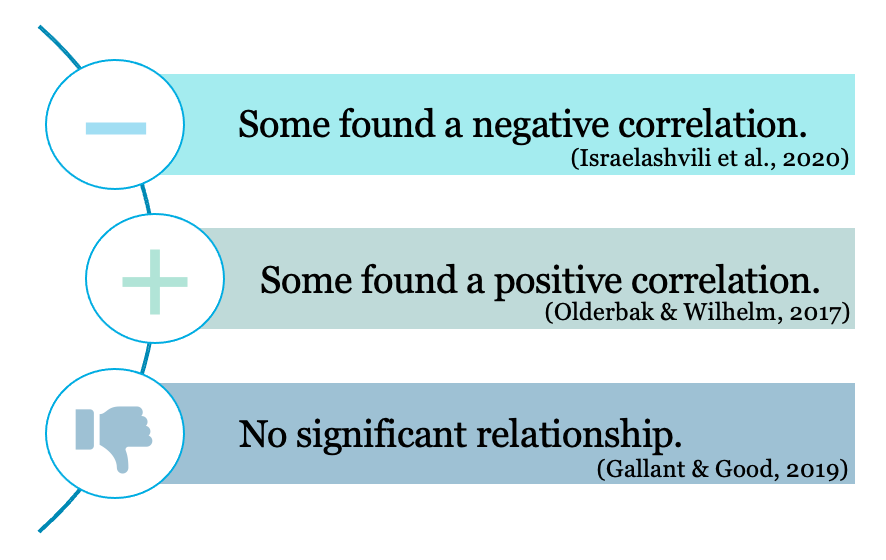
Besides ... Emotional states could play a role in predicting empathy too!
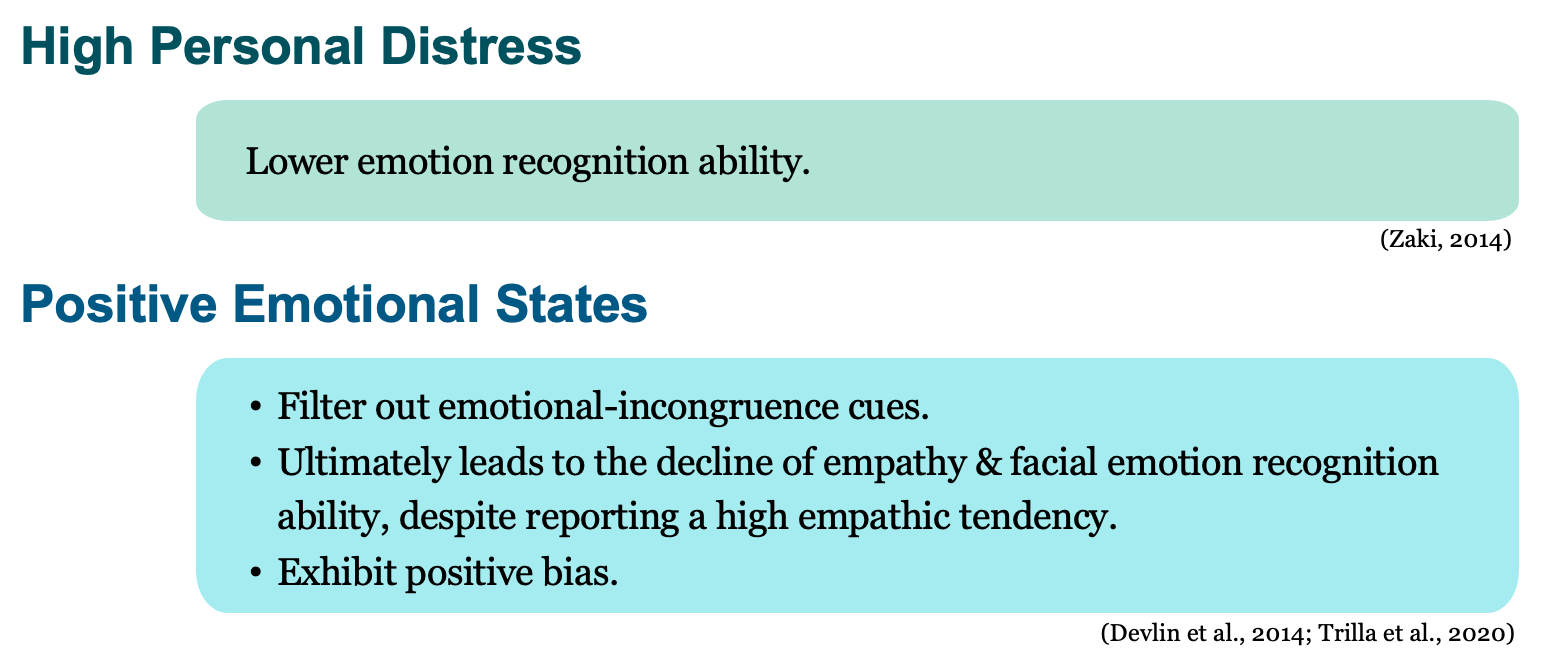
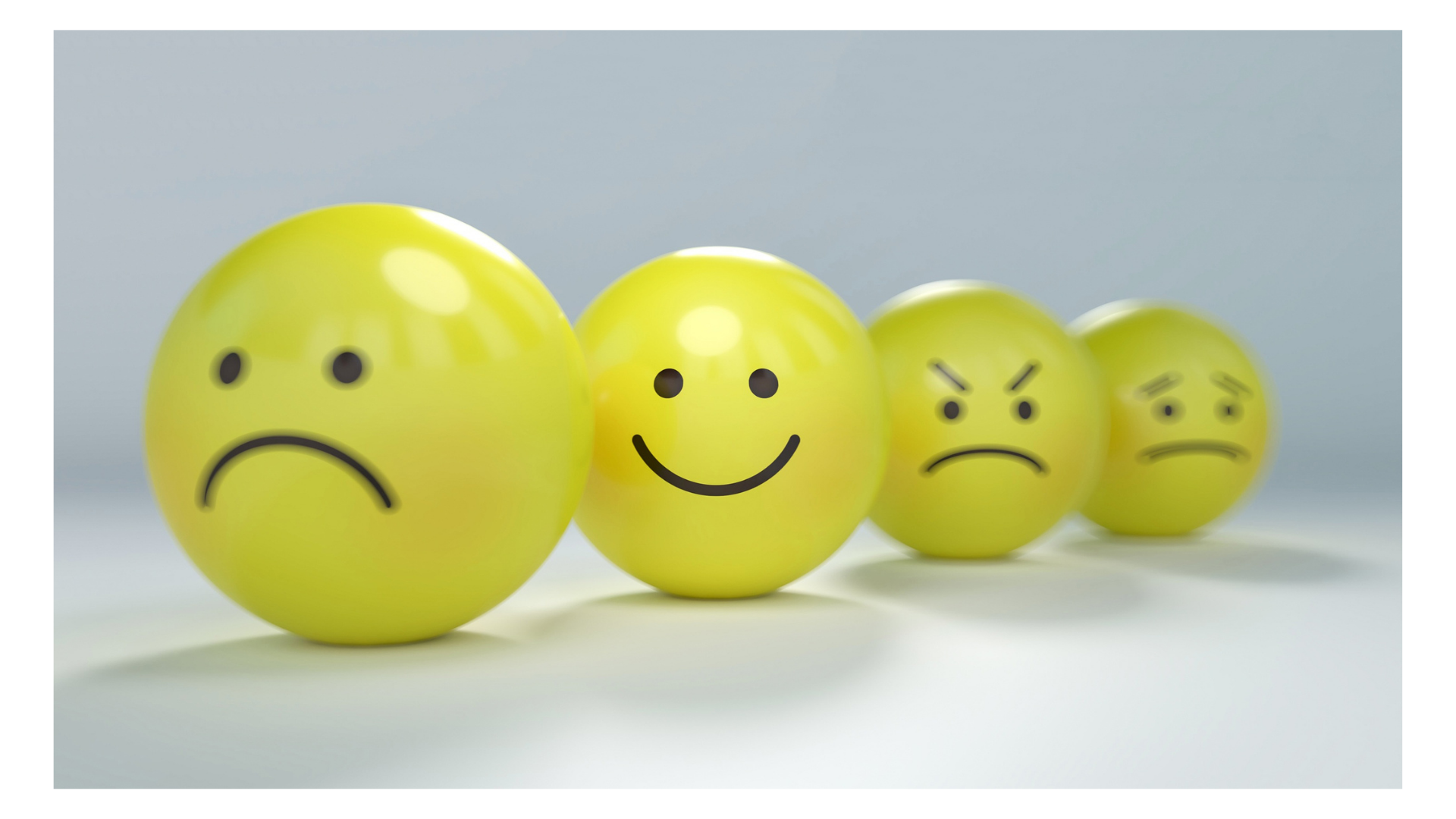
Nevertheless, the empathy amplification hypothesis put forwards contrary viewpoints. It suggests that positive emotional states would lead to the improvement of empathy level, because happy emotions often make individuals trust others more and develop good interpersonal relationships with others, thus they are more likely to care about or even provide help to those in need (Isen et al., 1976).
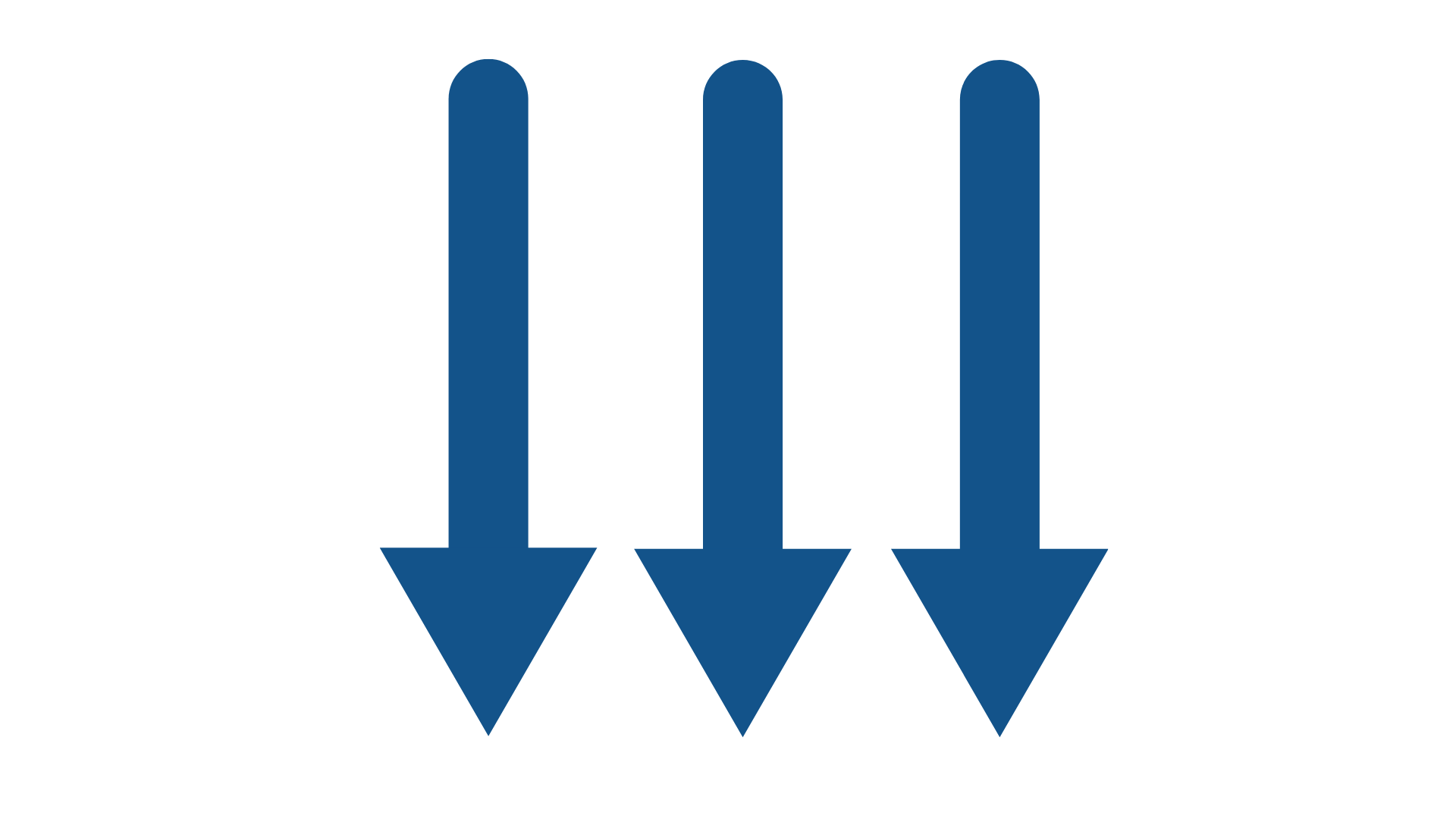
With these in mind ...
It is hoped that this research could help us to grasp a better understanding regarding the influence of empathic concern and positive emotional states on one's facial emotion recognition ability.
1. Does empathic concern lead to facial emotion recognition ?
2. Does positive emotional states increase OR decrease facial emotion recognition?


So,
How was this research carried out?
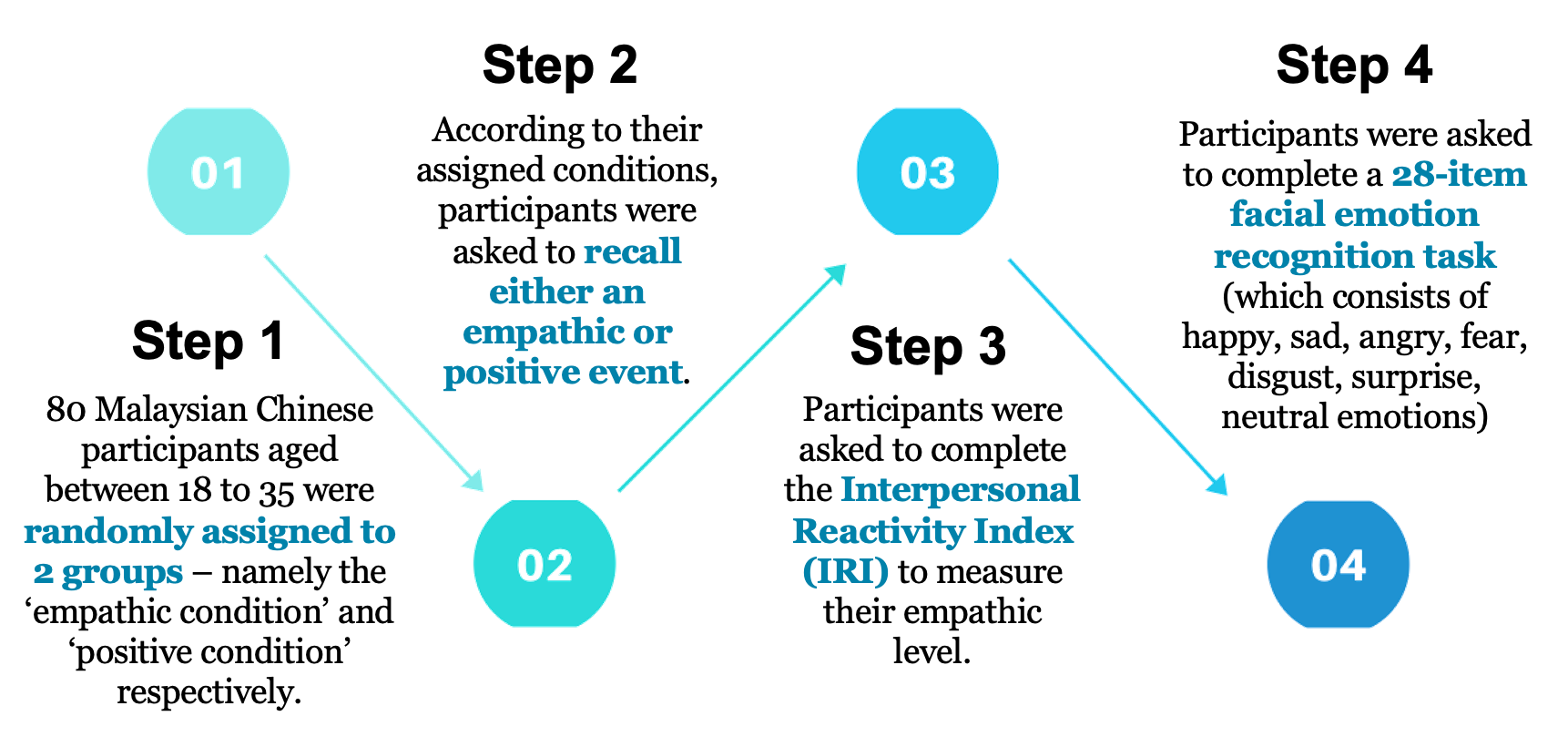
What has been found?
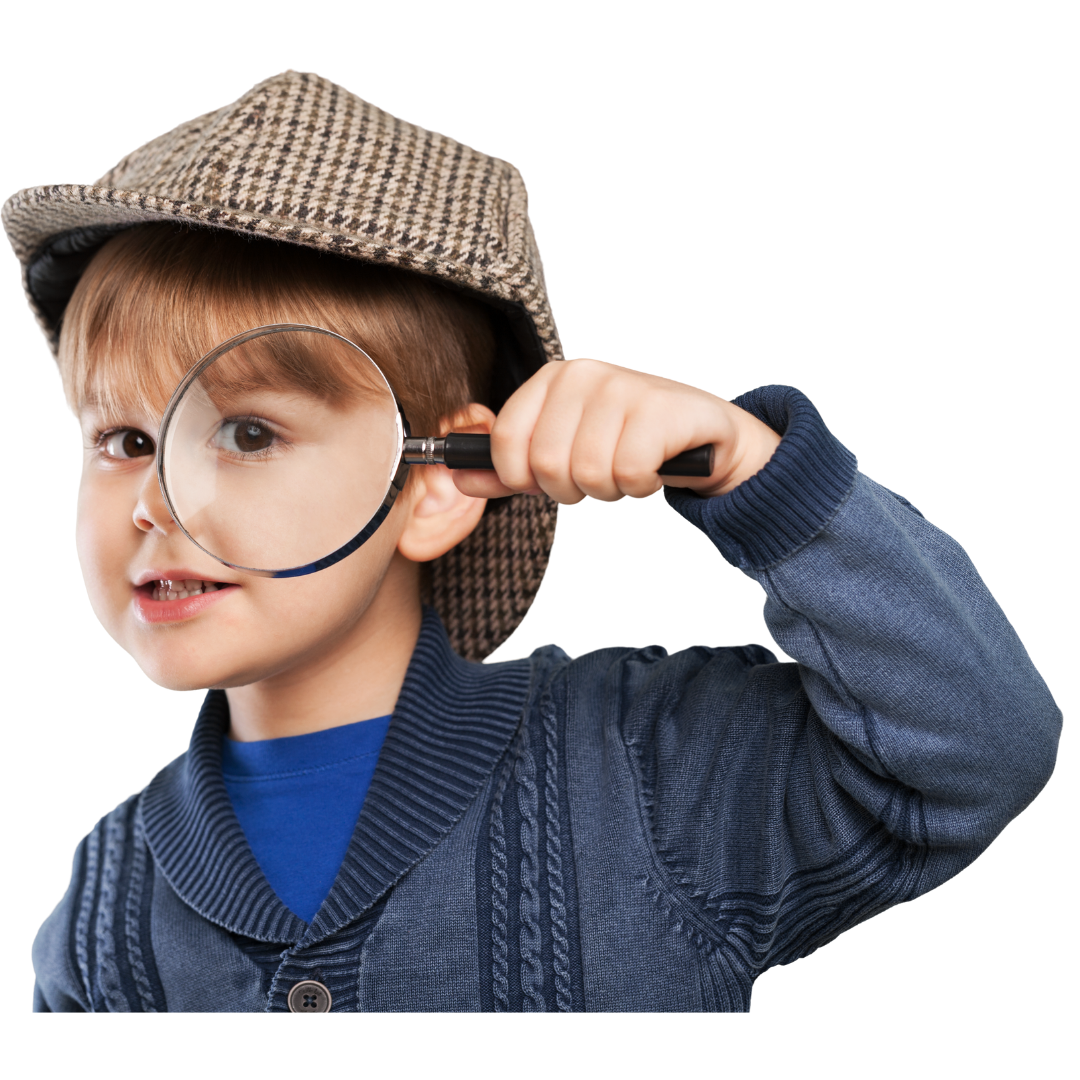
Swipe Down
For More!

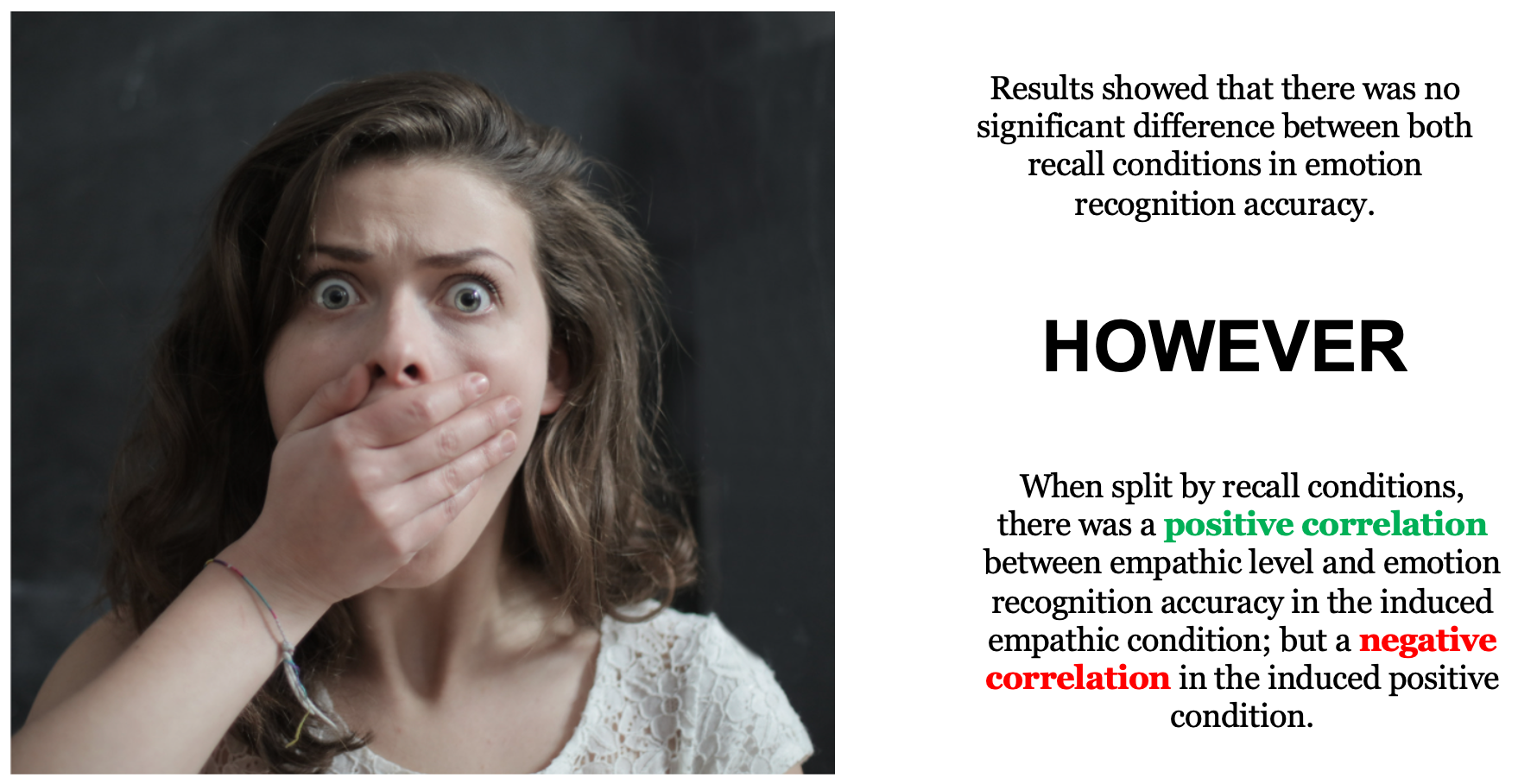


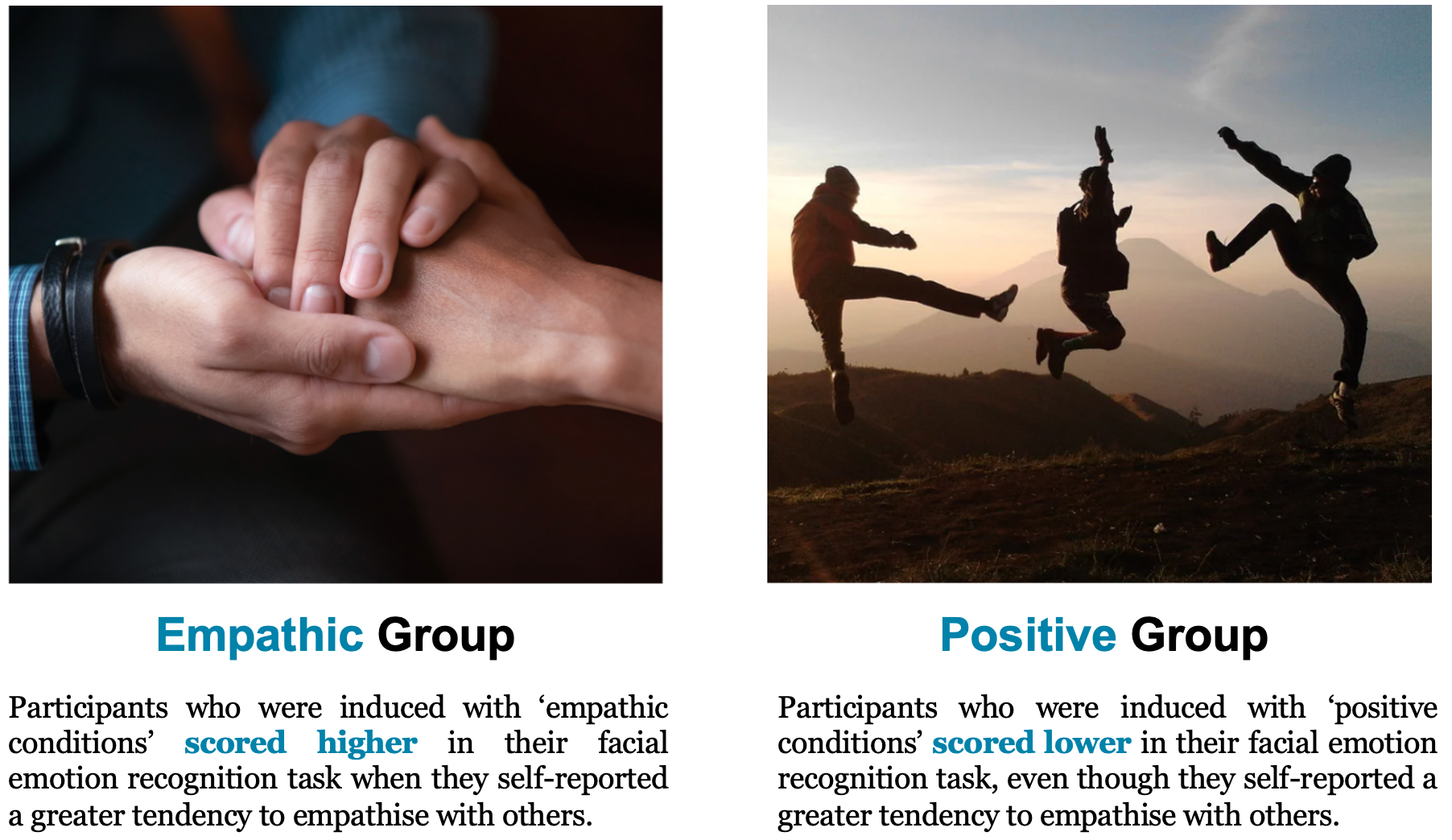
What do the results suggest?
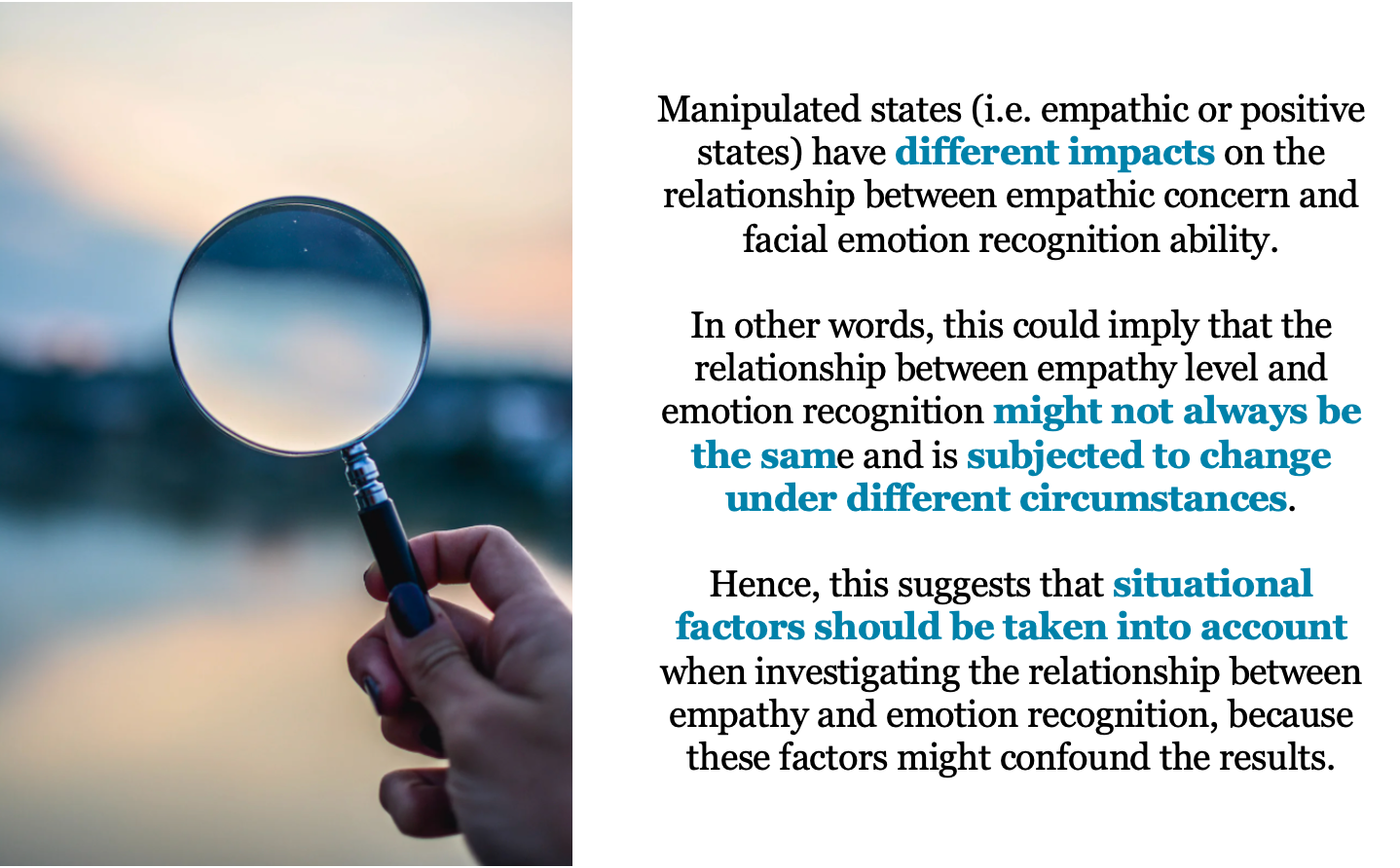
.
.
.
.
Conclusion
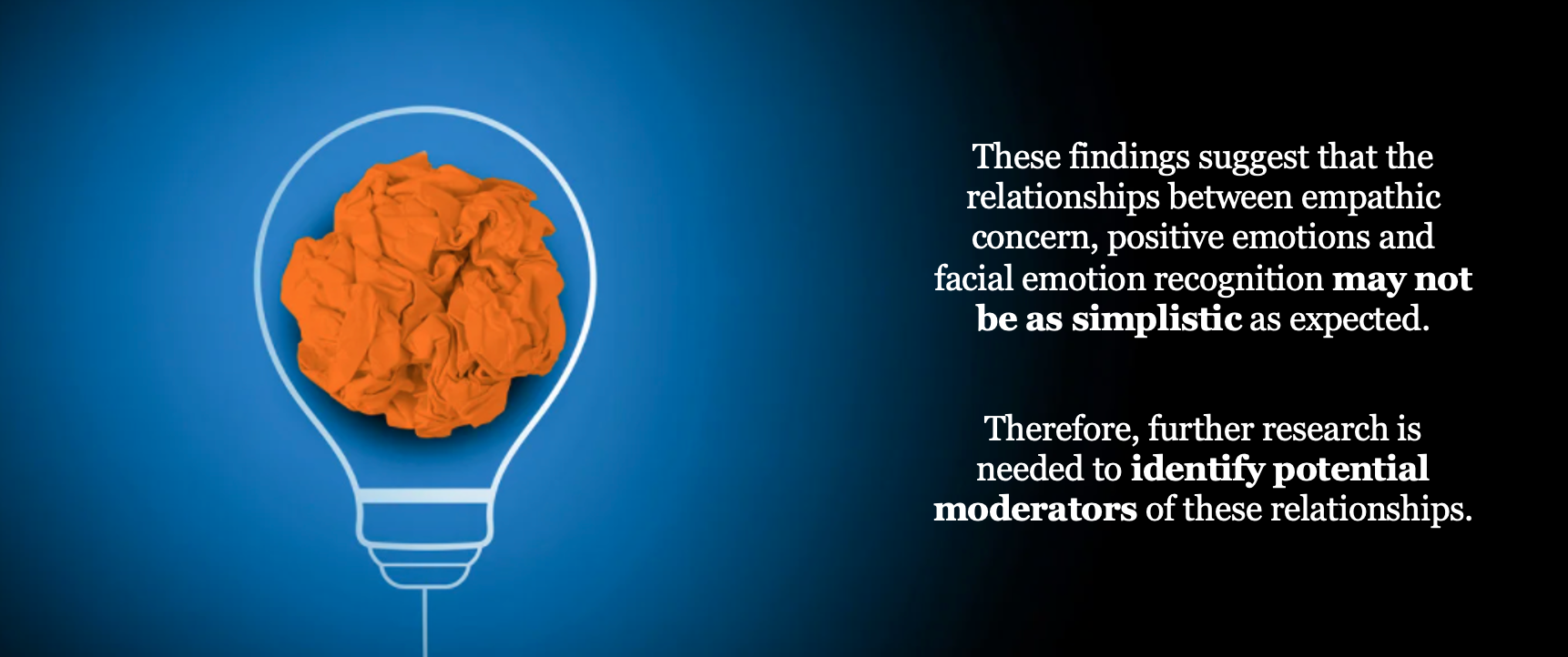
Reference
Devlin, H. C., Zaki, J., Ong, D. C., & Gruber, J. (2014). Not as good as you think? Trait positive emotion is associated with increased self-reported empathy but decreased empathic performance. PLoS ONE, 9(10), e110470. https://doi.org/10.1371/journal.pone.0110470
Gallant, C., & Good, D. (2020). Examining the “reading the mind in the eyes test” as an assessment of subtle differences in affective theory of mind after concussion. The Clinical Neuropsychologist, 34(2), 296–317. https://doi.org/10.1080/13854046.2019.1612946
Isen, A. M., Clark, M., & Schwartz, M. F. (1976). Duration of the effect of good mood on helping: ‘Footprints on the sands of time’. J Pers Soc Psychol, 34(3), 385-393. https://doi.org/10.1037/0022-3514.34.3.385
Israelashvili, J., Sauter, D., & Fischer, A. (2020). Two facets of affective empathy: Concern and distress have opposite relationships to emotion recognition. Cognition and Emotion, 34(6), 1112-1122. https://doi.org/10.1080/02699931.2020.1724893
Olderbak, S., & Wilhelm, O. (2017). Emotion perception and empathy: An individual differences test of relations. Emotion, 17(7), 1092-1106. https://doi.org/10.1037/emo0000308
Riess, H. (2017). The science of empathy. Journal of Patient Experience, 4(2), 74-77. https://doi.org/10.1177/2374373517699267
Sagi, A., & Hoffman, M. L. (1976). Empathic distress in newborns. Dev. Psychol, 12, 175–176. https://doi.org/10.1037/0012-1649.12.2.175
Trilla, I., Weigand, A., & Dziobek, I. (2020). Affective states influence emotion perception: Evidence for emotional egocentricity. Psychological Research, 85, 1005-1015. https://doi.org/10.1007/s00426-020-01314-3
Zaki, J. (2019). Empathy is a moral force. In K. Gray & J. Graham (Eds.), Atlas of moral psychology (pp. 49–58). The Guilford Press.
Acknowledgement
Supervisors:
Min-Hooi Yong
Ai-Suan Lee
Slide 1 image (max 2mb)
Slide 1 video (YouTube/Vimeo embed code)
Image 1 Caption
Slide 2 image (max 2mb)
Slide 2 video (YouTube/Vimeo embed code)
Image 2 Caption
Slide 3 image (max 2mb)
Slide 3 video (YouTube/Vimeo embed code)
Image 3 Caption
Slide 4 image (max 2mb)
Slide 4 video (YouTube/Vimeo embed code)
Image 4 Caption
Slide 5 image (max 2mb)
Slide 5 video (YouTube/Vimeo embed code)
Image 5 Caption
Slide 6 image (max 2mb)
Slide 6 video (YouTube/Vimeo embed code)
Image 6 Caption
Slide 7 image (max 2mb)
Slide 7 video (YouTube/Vimeo embed code)
Image 7 Caption
Slide 8 image (max 2mb)
Slide 8 video (YouTube/Vimeo embed code)
Image 8 Caption
Slide 9 image (max 2mb)
Slide 9 video (YouTube/Vimeo embed code)
Image 9 Caption
Slide 10 image (max 2mb)
Slide 20 video (YouTube/Vimeo embed code)
Image 10 Caption
Caption font
Text
Image (max size: 2mb)
Or drag a symbol into the upload area
















Image description/alt-tag
Image caption
Image link
Rollover Image (max size: 2mb)
Or drag a symbol into the upload area
















Border colour
Rotate
Skew (x-axis)
Skew (y-axis)
Image (max size: 2mb)
Or drag a symbol into the upload area
















Image description/alt-tag
Image caption
Image link
Rollover Image (max size: 2mb)
Or drag a symbol into the upload area
















Border colour
Rotate
Skew (x-axis)
Skew (y-axis)
Image (max size: 2mb)
Or drag a symbol into the upload area
















Image description/alt-tag
Image caption
Image link
Rollover Image (max size: 2mb)
Or drag a symbol into the upload area
















Border colour
Rotate
Skew (x-axis)
Skew (y-axis)
Image (max size: 2mb)
Or drag a symbol into the upload area
















Image description/alt-tag
Image caption
Image link
Rollover Image (max size: 2mb)
Or drag a symbol into the upload area
















Border colour
Rotate
Skew (x-axis)
Skew (y-axis)
Image (max size: 2mb)
Or drag a symbol into the upload area
















Image description/alt-tag
Image caption
Image link
Rollover Image (max size: 2mb)
Or drag a symbol into the upload area
















Border colour
Rotate
Skew (x-axis)
Skew (y-axis)
Image (max size: 2mb)
Or drag a symbol into the upload area
















Image description/alt-tag
Image caption
Image link
Rollover Image (max size: 2mb)
Or drag a symbol into the upload area
















Border colour
Rotate
Skew (x-axis)
Skew (y-axis)
Image (max size: 2mb)
Or drag a symbol into the upload area
















Image description/alt-tag
Image caption
Image link
Rollover Image (max size: 2mb)
Or drag a symbol into the upload area
















Border colour
Rotate
Skew (x-axis)
Skew (y-axis)
Image (max size: 2mb)
Or drag a symbol into the upload area
















Image description/alt-tag
Image caption
Image link
Rollover Image (max size: 2mb)
Or drag a symbol into the upload area
















Border colour
Rotate
Skew (x-axis)
Skew (y-axis)
Image (max size: 2mb)
Or drag a symbol into the upload area
















Image description/alt-tag
Image caption
Image link
Rollover Image (max size: 2mb)
Or drag a symbol into the upload area
















Border colour
Rotate
Skew (x-axis)
Skew (y-axis)
Image (max size: 2mb)
Or drag a symbol into the upload area
















Image description/alt-tag
Image caption
Image link
Rollover Image (max size: 2mb)
Or drag a symbol into the upload area
















Border colour
Rotate
Skew (x-axis)
Skew (y-axis)
Image (max size: 2mb)
Or drag a symbol into the upload area
















Image description/alt-tag
Image caption
Image link
Rollover Image (max size: 2mb)
Or drag a symbol into the upload area
















Border colour
Rotate
Skew (x-axis)
Skew (y-axis)
Image (max size: 2mb)
Or drag a symbol into the upload area
















Image description/alt-tag
Image caption
Image link
Rollover Image (max size: 2mb)
Or drag a symbol into the upload area
















Border colour
Rotate
Skew (x-axis)
Skew (y-axis)
Image (max size: 2mb)
Or drag a symbol into the upload area
















Image description/alt-tag
Image caption
Image link
Rollover Image (max size: 2mb)
Or drag a symbol into the upload area
















Border colour
Rotate
Skew (x-axis)
Skew (y-axis)
Image (max size: 2mb)
Or drag a symbol into the upload area
















Image description/alt-tag
Image caption
Image link
Rollover Image (max size: 2mb)
Or drag a symbol into the upload area
















Border colour
Rotate
Skew (x-axis)
Skew (y-axis)
Image (max size: 2mb)
Or drag a symbol into the upload area
















Image description/alt-tag
Image caption
Image link
Rollover Image (max size: 2mb)
Or drag a symbol into the upload area
















Border colour
Rotate
Skew (x-axis)
Skew (y-axis)
Image (max size: 2mb)
Or drag a symbol into the upload area
















Image description/alt-tag
Image caption
Image link
Rollover Image (max size: 2mb)
Or drag a symbol into the upload area
















Border colour
Rotate
Skew (x-axis)
Skew (y-axis)
Image (max size: 2mb)
Or drag a symbol into the upload area
















Image description/alt-tag
Image caption
Image link
Rollover Image (max size: 2mb)
Or drag a symbol into the upload area
















Border colour
Rotate
Skew (x-axis)
Skew (y-axis)
Image (max size: 2mb)
Or drag a symbol into the upload area
















Image description/alt-tag
Image caption
Image link
Rollover Image (max size: 2mb)
Or drag a symbol into the upload area
















Border colour
Rotate
Skew (x-axis)
Skew (y-axis)
Image (max size: 2mb)
Or drag a symbol into the upload area
















Image description/alt-tag
Image caption
Image link
Rollover Image (max size: 2mb)
Or drag a symbol into the upload area
















Border colour
Rotate
Skew (x-axis)
Skew (y-axis)
Image (max size: 2mb)
Or drag a symbol into the upload area
















Image description/alt-tag
Image caption
Image link
Rollover Image (max size: 2mb)
Or drag a symbol into the upload area
















Border colour
Rotate
Skew (x-axis)
Skew (y-axis)
Image (max size: 2mb)
Or drag a symbol into the upload area
















Image description/alt-tag
Image caption
Image link
Rollover Image (max size: 2mb)
Or drag a symbol into the upload area
















Border colour
Rotate
Skew (x-axis)
Skew (y-axis)
Image (max size: 2mb)
Or drag a symbol into the upload area
















Image description/alt-tag
Image caption
Image link
Rollover Image (max size: 2mb)
Or drag a symbol into the upload area
















Border colour
Rotate
Skew (x-axis)
Skew (y-axis)
Image (max size: 2mb)
Or drag a symbol into the upload area
















Image description/alt-tag
Image caption
Image link
Rollover Image (max size: 2mb)
Or drag a symbol into the upload area
















Border colour
Rotate
Skew (x-axis)
Skew (y-axis)
Image (max size: 2mb)
Or drag a symbol into the upload area
















Image description/alt-tag
Image caption
Image link
Rollover Image (max size: 2mb)
Or drag a symbol into the upload area
















Border colour
Rotate
Skew (x-axis)
Skew (y-axis)